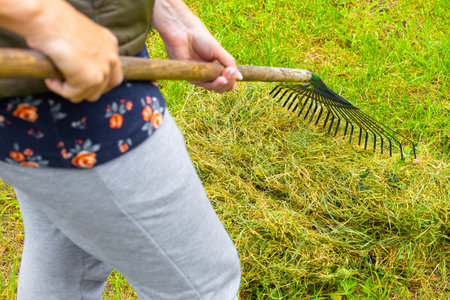Getting to Know Your Rake: An American Garden Classic
In American backyards, the humble rake is more than just a tool—it’s a seasonal companion and a symbol of homegrown pride. Whether you’re tackling autumn leaves or prepping spring garden beds, rakes are essential for keeping outdoor spaces tidy and healthy. For generations, families across the U.S. have reached for their favorite rakes as part of annual rituals—think kids jumping into leaf piles or neighbors helping each other clear up after a summer storm. Rakes come in many shapes and sizes, each suited to specific garden chores, but they all share one thing: they make yard work doable and even enjoyable. As we cycle through the seasons, from crisp fall days to fresh spring mornings, having the right rake on hand helps us care for our lawns, gardens, and family memories alike.
2. Leaf Rakes: Fall Clean-Up’s Best Friend
If you’ve ever spent an autumn afternoon making leaf piles with your kids or neighbors, you know the value of a good leaf rake. In American yards, leaf rakes are almost as iconic as pumpkin pie in October. But what makes a leaf rake so special, and why should every family have one on hand when the leaves start to fall?
Design Features of Leaf Rakes
Leaf rakes are designed with wide, fan-shaped heads and long flexible tines—usually made from plastic, metal, or bamboo. The width lets you cover more ground with each sweep, while the bendy tines glide over grass and snag up leaves without digging into your lawn. Many handles are lightweight and come in various lengths to fit both adults and kids.
| Material | Pros | Cons |
|---|---|---|
| Plastic | Lightweight, rust-proof, budget-friendly | Can crack in cold weather |
| Metal | Durable, effective on wet leaves | Heavier, may rust if not cared for |
| Bamboo | Eco-friendly, gentle on delicate lawns | Less durable, not for heavy-duty use |
Best Uses for Leaf Rakes
- Autumn Leaf Clean-Up: Gather fallen leaves quickly without damaging grass roots.
- General Lawn Debris: Pick up twigs, grass clippings, or pine needles after mowing.
- Kid-Friendly Chores: Lightweight designs make it easy (and even fun) for children to help out.
- Compost Prep: Collect organic material for compost bins easily.
Local Tips for Maximum Efficiency
- If your yard has lots of trees (maple or oak, especially), invest in a wide-head plastic rake to speed up the job.
- Avoid raking when leaves are wet—they’re heavier and harder to move. Wait until the sun dries them out a bit.
- Create smaller piles across your yard rather than dragging everything to one giant heap; this makes bagging easier and keeps everyone involved.
- If you compost, skip the bags! Instead, rake leaves directly onto your compost pile or garden beds as mulch.
The Heart of Fall Family Traditions
No matter your garden size, a leaf rake is essential for that all-American autumn clean-up. It’s more than just a tool—it’s part of family memories: jumping into crunchy piles, making chores playful, and keeping your yard tidy for seasonal gatherings. Invest in a sturdy leaf rake this year—you’ll be glad you did when those golden leaves start to fall!
![]()
3. Bow Rakes: Dig Deeper in Your Garden Beds
When you’re ready to take your American backyard garden to the next level, a bow rake is your go-to tool. Unlike leaf rakes, which are made for gathering light debris, bow rakes are all about getting down and dirty with your soil. Their short, sturdy tines are designed to break up clods of earth, spread mulch evenly, and help prep your garden beds for planting. This makes them a staple in gardens across the U.S., especially when it’s time to turn over new ground or refresh old beds.
Bow rakes have a flat head attached securely with two metal arms (the “bow”), giving them extra strength and durability. American gardeners love using bow rakes for tasks like leveling out compost, smoothing gravel paths, or mixing amendments into their veggie patches. With just a bit of muscle, you can use a bow rake to pull rocks from the soil or even shape your raised beds. It’s not just about brute force – a good bow rake helps you work smarter, not harder.
If you’re planning to grow tomatoes in Texas clay or lay down new mulch for your perennial border in Ohio, the bow rake will quickly become your best friend. Its versatility means it’s used coast to coast, from prepping California flower beds in spring to cleaning up autumn gardens in Vermont. For anyone serious about their homegrown harvests or curb appeal, investing in a sturdy bow rake is an absolute must.
4. Specialty Rakes: From Lawn Care to Zen Moments
When it comes to rakes, most folks picture the classic leaf rake or sturdy bow rake—but there’s a whole world of specialty rakes designed for unique tasks around your yard and garden. Knowing when to use these tools can make your outdoor chores smoother and even bring a little calm to your daily routine. Let’s dig into some lesser-known but super useful types of rakes.
Lawn Rakes: For That Perfect Turf
Lawn rakes, sometimes called thatch rakes, are engineered with flexible tines to help remove thatch buildup—those layers of old grass and debris that can suffocate your lawn. They’re great for keeping your grass healthy without tearing up the roots. If you want a lush, green lawn come summer, this is the rake for you.
Shrub Rakes: Tight Spaces Made Easy
Shrub rakes are the little siblings of leaf rakes, sporting a narrow head and shorter handle. This design makes them ideal for cleaning under bushes, between perennials, or in those tricky corners where bigger rakes just won’t fit. If you’ve got a lot of landscaping or tight garden beds, keep one handy.
Zen & Sand Rakes: More Than Just Tools
If you’ve ever admired a peaceful Japanese rock garden, you’ve seen zen rakes in action. These small rakes are perfect for creating patterns in sand or gravel—bringing a touch of mindfulness and beauty to your backyard or meditation space. While not everyone has a zen garden, using one of these rakes can be a calming way to unwind after a day’s work.
Quick Guide: Specialty Rake Uses
| Rake Type | Main Use | Best For |
|---|---|---|
| Lawn Rake | Removing thatch & light debris | Maintaining turf health |
| Shrub Rake | Clearing leaves from tight spaces | Beds, under shrubs, garden corners |
| Zen/Sand Rake | Patterning sand/gravel; relaxation | Zen gardens, meditation areas |
When Should You Reach for a Specialty Rake?
If you find yourself struggling with regular rakes around delicate plants, in compact spaces, or when aiming for that perfectly groomed lawn, it might be time to add a specialty rake (or two) to your tool shed. And if you’re craving a little peace at the end of the day? Try picking up a zen rake—you might just find it’s as good for your mind as it is for the sand.
5. Choosing the Right Rake for Your Yard
Picking the best rake for your family’s outdoor space isn’t just about grabbing whatever’s on sale at the hardware store. You want a tool that makes your yard work smoother, saves your back, and lasts through many fall seasons. Start by thinking about the size of your yard. If you have a big lawn with lots of trees, a wide leaf rake made from lightweight materials like plastic or aluminum will help you cover more ground quickly. For smaller yards or tight spaces—like flower beds or under shrubs—a narrower rake gives you better control.
Material matters, too. Metal rakes are sturdy and great for tough jobs like moving gravel or leveling soil, but they can be heavy for kids or folks with less upper body strength. Plastic rakes are lighter and perfect for leaves, but might not hold up as well with heavier debris. Wood handles offer a classic feel and stay comfortable in cooler weather, while fiberglass handles are durable and splinter-resistant.
Comfort is key, especially if you’re raking with family members of different ages and sizes. Look for ergonomic grips or padded handles, and check if the rake’s length matches the main user’s height—no one wants to end up with a sore back from stooping over! Some families even keep a couple of rakes on hand: one sturdy bow rake for heavy-duty tasks, and a flexible leaf rake for everyday clean-up. Whatever you choose, a good rake should feel like an extension of your own two hands—ready to help you care for your outdoor home year after year.
6. Care Tips: Making Your Garden Rake Last for Seasons
Keeping your garden rake in top shape doesn’t have to be a chore. With just a few easy habits, you can make sure your trusty tool is ready for action season after season—whether you’re dealing with fall leaves in the Midwest or prepping raised beds in sunny California. Here’s how to care for your rakes the American way:
How to Clean Your Rake
After each use, give your rake a quick shake or tap against the ground to remove loose dirt and debris. For more stubborn mud, rinse the tines with a garden hose and scrub gently with an old brush if needed. Dry thoroughly—leaving moisture on metal parts can lead to rust, especially in humid climates.
Pro Tip:
Keep a rag or old towel by your garage door so you can wipe down tools before storing them. This small habit pays off big over time!
Proper Storage Matters
Avoid leaving your rake lying out in the yard where weather and sunlight can warp wooden handles and weaken plastic tines. Hang your rakes on sturdy hooks in the garage, shed, or even along the side of your house under an awning. If space is tight, consider an inexpensive wall-mounted tool rack from your local hardware store—these are popular in American homes for keeping gear organized and off the ground.
Family-Friendly Storage Idea:
If you’ve got little helpers at home, store smaller kids’ rakes lower on the wall so they can learn responsibility for their own tools!
Simple Maintenance Routines
Once or twice a year, give your rake some extra TLC. Lightly sand any splinters on wood handles and rub in boiled linseed oil to prevent drying and cracking (a classic tip passed down in many American families). Tighten any loose screws or bolts, and check metal tines for bends—gently straighten them out with pliers if needed. For rust spots, use steel wool or a wire brush to clean up the area and finish with a spritz of protective spray like WD-40.
Remember:
A little regular care means your leaf rake or bow rake will be ready when you need it most—saving you time, money, and hassle every gardening season.


